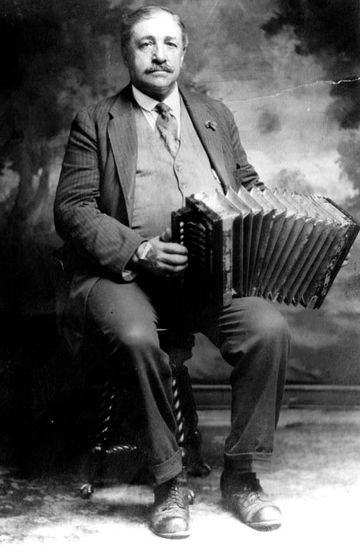Annotation:Rags (The): Difference between revisions
No edit summary |
No edit summary |
||
| Line 4: | Line 4: | ||
|f_annotation=[[File:montmarquette.jpg|360px|thumb|right|Alfred Montmarquette]]'''RAGS, THE''' (Les Guenilles). AKA – "[[Guenille (La)]]," "[[Guénille (La)]]," "[[Reel de la guénille]]." French-Canadian, Reel and Air. D Major. Standard tuning (fiddle). AABBCCCC (Phillips): AA'BB'CC' (Reiner & Anick). A common French-Canadian reel, according to David Green in the liner notes to “Louis Beaudoin” (Philo Records, 1973). The title refers to a piece of cloth, not 'ragtime' rhythm. The tune was popularized through the performances of accordion player [[wikipedia:Alfred Montmarquette]] (1871–1944) and singer Mary Travers (La Bolduc), who set words to it. It was also recorded by fiddlers Joseph Allard and Isidore Soucy and by numerous accordion players. | |f_annotation=[[File:montmarquette.jpg|360px|thumb|right|Alfred Montmarquette]]'''RAGS, THE''' (Les Guenilles). AKA – "[[Guenille (La)]]," "[[Guénille (La)]]," "[[Reel de la guénille]]." French-Canadian, Reel and Air. D Major. Standard tuning (fiddle). AABBCCCC (Phillips): AA'BB'CC' (Reiner & Anick). A common French-Canadian reel, according to David Green in the liner notes to “Louis Beaudoin” (Philo Records, 1973). The title refers to a piece of cloth, not 'ragtime' rhythm. The tune was popularized through the performances of accordion player [[wikipedia:Alfred Montmarquette]] (1871–1944) and singer Mary Travers (La Bolduc), who set words to it. It was also recorded by fiddlers Joseph Allard and Isidore Soucy and by numerous accordion players. | ||
|f_source_for_notated_version=Dennis Mathieu via Louis Beaudoin (1921–1980, Burlington, Vt.) [Reiner & Anick]; Ken Kosek [Phillips]. | |f_source_for_notated_version=Dennis Mathieu via Louis Beaudoin (1921–1980, Burlington, Vt.) [Reiner & Anick]; Ken Kosek [Phillips]. | ||
|f_printed_sources=Hart & Sandall ('''Dance ce soir!'''), 2001; No. 14, p. 47. | |f_printed_sources=Olivier Demers ('''1000 airs du Québec et de l’Amérique francophone'''), 2020; p. 107. | ||
Hart & Sandall ('''Dance ce soir!'''), 2001; No. 14, p. 47. | |||
Phillips ('''Traditional American Fiddle Tunes, vol. 1'''), 1994; p. 194. | Phillips ('''Traditional American Fiddle Tunes, vol. 1'''), 1994; p. 194. | ||
Reiner & Anick ('''Old-Time Fiddling Across America'''), 1989; p. 64. | Reiner & Anick ('''Old-Time Fiddling Across America'''), 1989; p. 64. | ||
Revision as of 01:04, 27 May 2021
X:1 T:Guenilles, Les T:Rags, The M:C| L:1/8 R:Reel N:M. Beaudoin played each part three times. D:Philo Records - "Louis Beaudoin" (1973) D:https://www.youtube.com/watch?v=HRhhNNiblxs Z:Andrew Kuntz K:D Acdd fdfd|cdef gfgB|Aceg fdfd|efec d2d2| Acdd fdfd|cdef gfg2|Aceg fdfd|1,2egec d2d2:|3egec d3|| |:a|a2ag fdfd|Acde gefg|abag fdfd|egec d3:| |:f|gage fgfg/f/|edcB Acef|gage f2 fg/f/|egec d3:|


